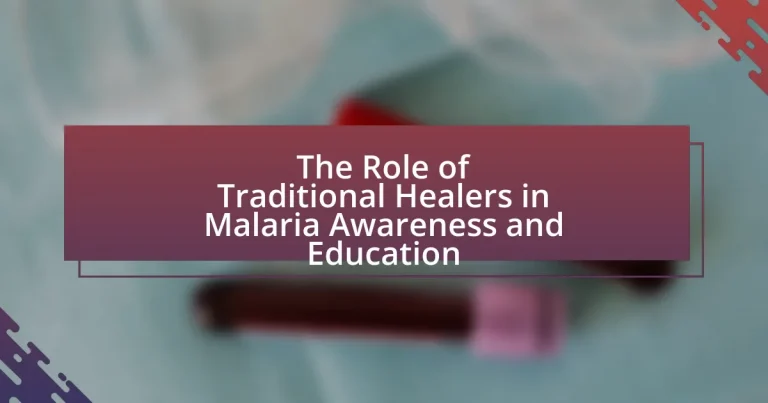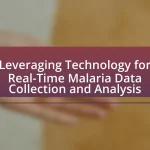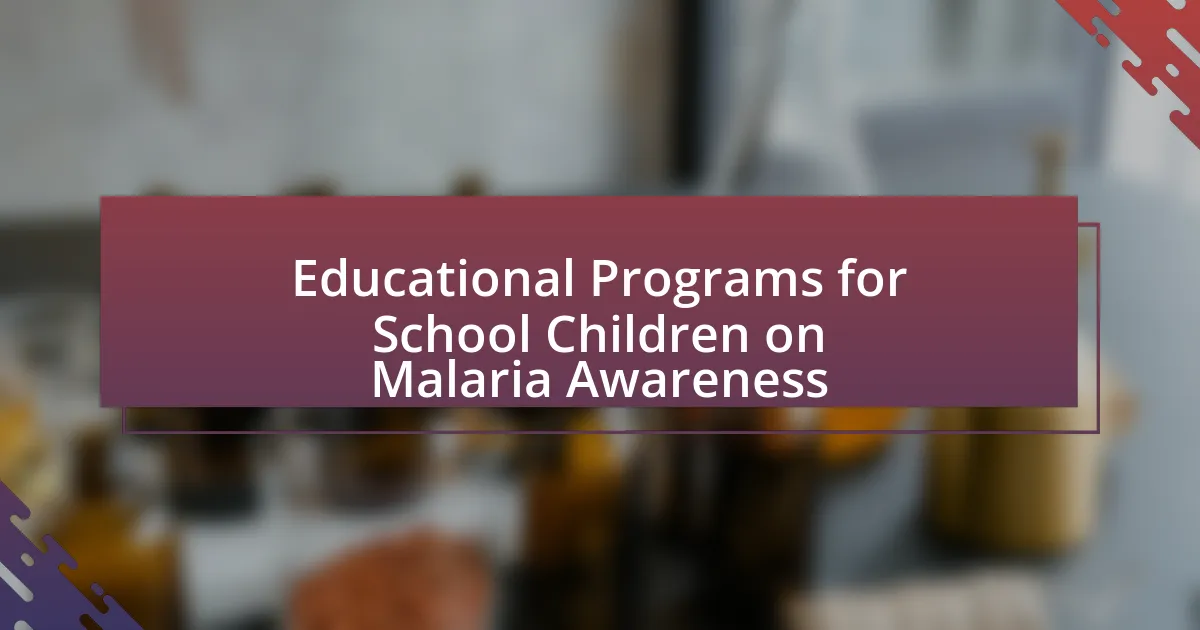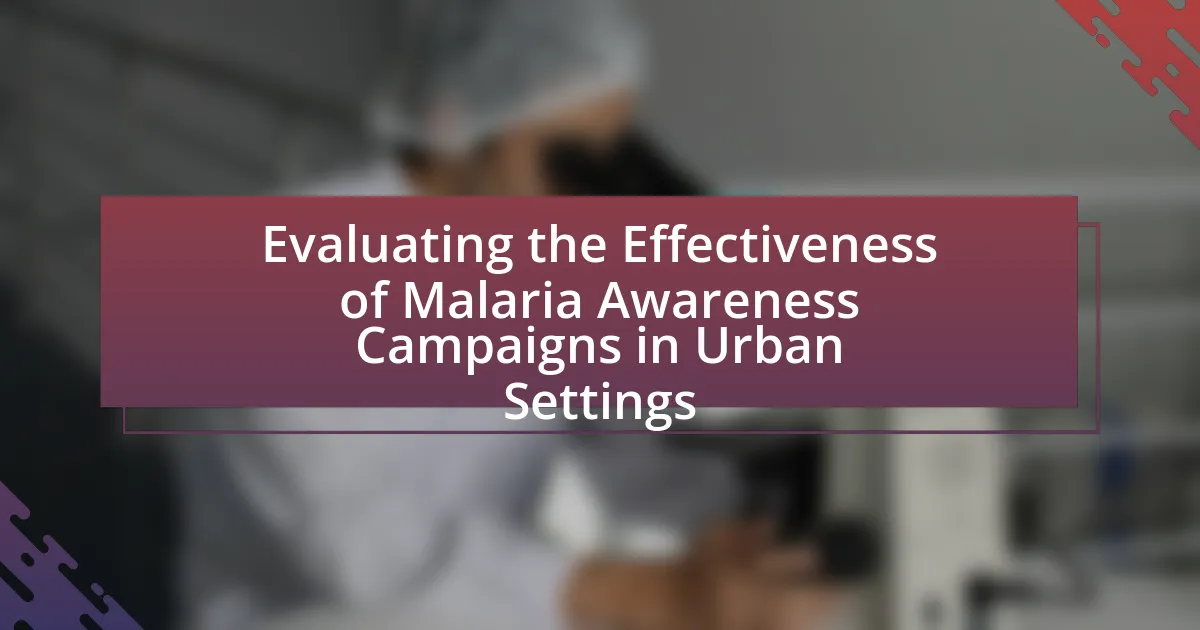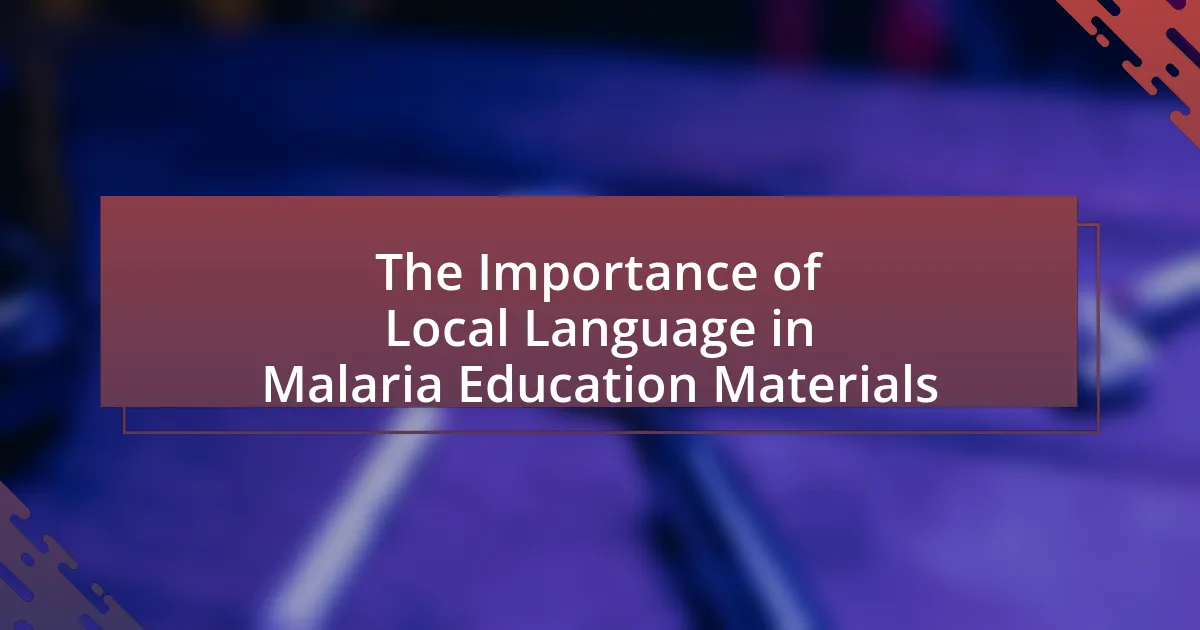Traditional healers play a vital role in malaria awareness and education, acting as trusted sources of health information within their communities. They utilize their extensive knowledge of local medicinal practices to educate individuals about malaria prevention, symptoms, and treatment options. The article explores how traditional healers contribute to malaria awareness through community engagement, storytelling, and practical demonstrations, while also addressing the challenges they face, such as misconceptions and lack of resources. Additionally, it highlights the importance of integrating traditional healing practices with modern medicine to enhance public health outcomes and improve community understanding of malaria.
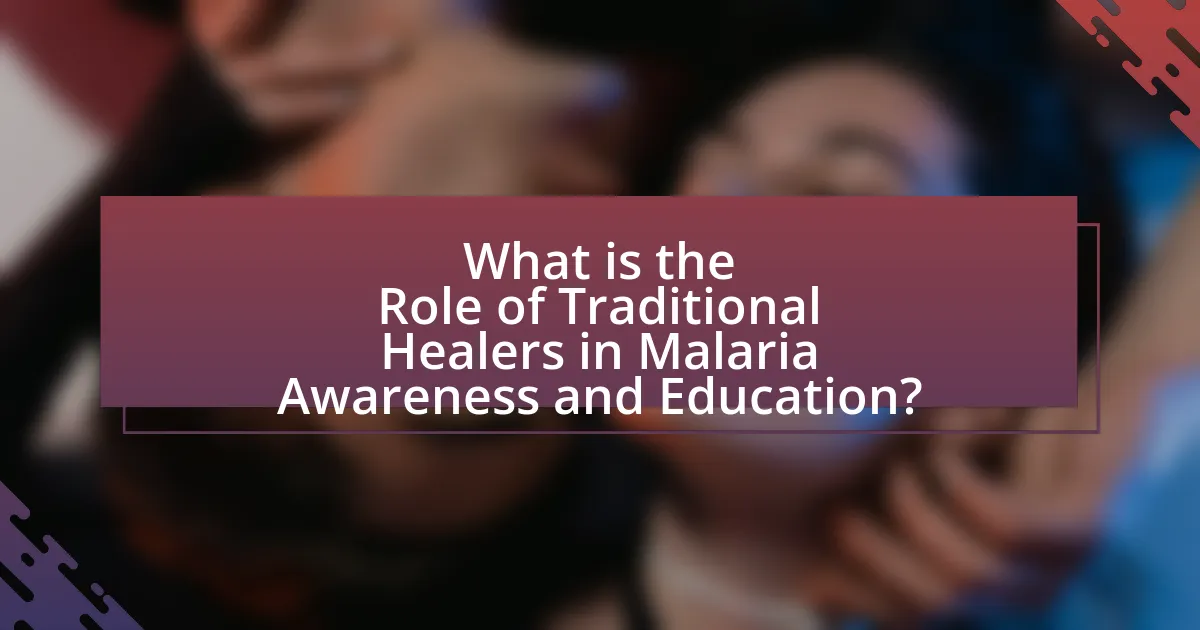
What is the Role of Traditional Healers in Malaria Awareness and Education?
Traditional healers play a crucial role in malaria awareness and education by serving as trusted sources of health information within their communities. They often possess extensive knowledge of local medicinal plants and traditional practices, which they use to educate individuals about malaria prevention and treatment. Research indicates that traditional healers can effectively disseminate information about malaria symptoms, transmission, and preventive measures, thereby enhancing community understanding and response to the disease. For instance, a study published in the “Malaria Journal” highlighted that integrating traditional healers into formal health systems improved malaria case management and increased community engagement in malaria control efforts. This collaboration leverages the healers’ influence and rapport with the community, making malaria education more accessible and culturally relevant.
How do traditional healers contribute to malaria awareness?
Traditional healers contribute to malaria awareness by educating communities about the disease and its prevention methods. They often serve as trusted sources of health information, utilizing their cultural knowledge to disseminate facts about malaria transmission, symptoms, and the importance of seeking medical treatment. For instance, studies have shown that traditional healers can effectively communicate the significance of using insecticide-treated bed nets and the need for early diagnosis, thereby enhancing community understanding and response to malaria. Their involvement in local health initiatives further amplifies awareness, as they bridge the gap between modern medical practices and traditional beliefs, fostering a more comprehensive approach to malaria education.
What methods do traditional healers use to educate communities about malaria?
Traditional healers use community gatherings, storytelling, and herbal demonstrations to educate communities about malaria. These methods facilitate the sharing of knowledge regarding malaria prevention, symptoms, and treatment options. For instance, community gatherings allow healers to engage directly with individuals, fostering dialogue and addressing misconceptions about malaria. Storytelling serves as a cultural tool to convey important health messages in an accessible manner, often incorporating local beliefs and practices. Herbal demonstrations provide practical insights into the use of traditional remedies, which can complement modern medical approaches. These methods are effective in enhancing community awareness and understanding of malaria, thereby contributing to public health efforts.
How effective are traditional healers in raising awareness about malaria prevention?
Traditional healers are effective in raising awareness about malaria prevention, particularly in communities where they are trusted and frequently consulted for health issues. Studies indicate that traditional healers often serve as primary health advisors, providing culturally relevant information about malaria prevention methods, such as the use of insecticide-treated nets and environmental management. For instance, a study published in the “Malaria Journal” by M. A. A. M. M. A. et al. (2018) found that integrating traditional healers into malaria education programs significantly improved community knowledge and practices regarding malaria prevention. This effectiveness is attributed to their established relationships within the community, which facilitate the dissemination of health information in a manner that resonates with local beliefs and practices.
Why are traditional healers important in malaria education?
Traditional healers are important in malaria education because they serve as trusted sources of health information within their communities. Their deep understanding of local beliefs and practices allows them to effectively communicate the risks of malaria and promote preventive measures, such as the use of insecticide-treated bed nets and the importance of seeking medical care. Studies have shown that integrating traditional healers into formal health education programs can enhance community engagement and improve health outcomes, as they can bridge the gap between conventional medicine and local health practices. For instance, a study published in the “Journal of Ethnobiology and Ethnomedicine” highlighted that communities with active involvement of traditional healers reported higher awareness levels about malaria prevention strategies.
What cultural significance do traditional healers hold in their communities?
Traditional healers hold significant cultural importance in their communities as they serve as trusted sources of health care, knowledge, and spiritual guidance. They are often seen as custodians of indigenous medical practices and cultural heritage, which fosters community identity and continuity. For instance, in many African societies, traditional healers are integral to the healthcare system, providing remedies and treatments that are culturally accepted and accessible, especially in rural areas where modern medical facilities may be scarce. Their role extends beyond physical healing; they also address social and spiritual issues, reinforcing community bonds and cultural values. This multifaceted role underscores their significance in promoting health awareness, including education about diseases like malaria, where traditional healers often collaborate with health organizations to disseminate information and practices that align with local beliefs and customs.
How do traditional beliefs influence perceptions of malaria and its treatment?
Traditional beliefs significantly influence perceptions of malaria and its treatment by shaping how communities understand the disease and its causes. In many cultures, malaria is often attributed to supernatural forces or imbalances in the body, leading individuals to seek traditional healers rather than conventional medical treatment. For instance, a study in Nigeria found that 70% of respondents believed that malaria was caused by spiritual factors, which directly affected their willingness to use modern antimalarial drugs. This reliance on traditional healing practices can delay effective treatment and contribute to higher morbidity and mortality rates associated with malaria.
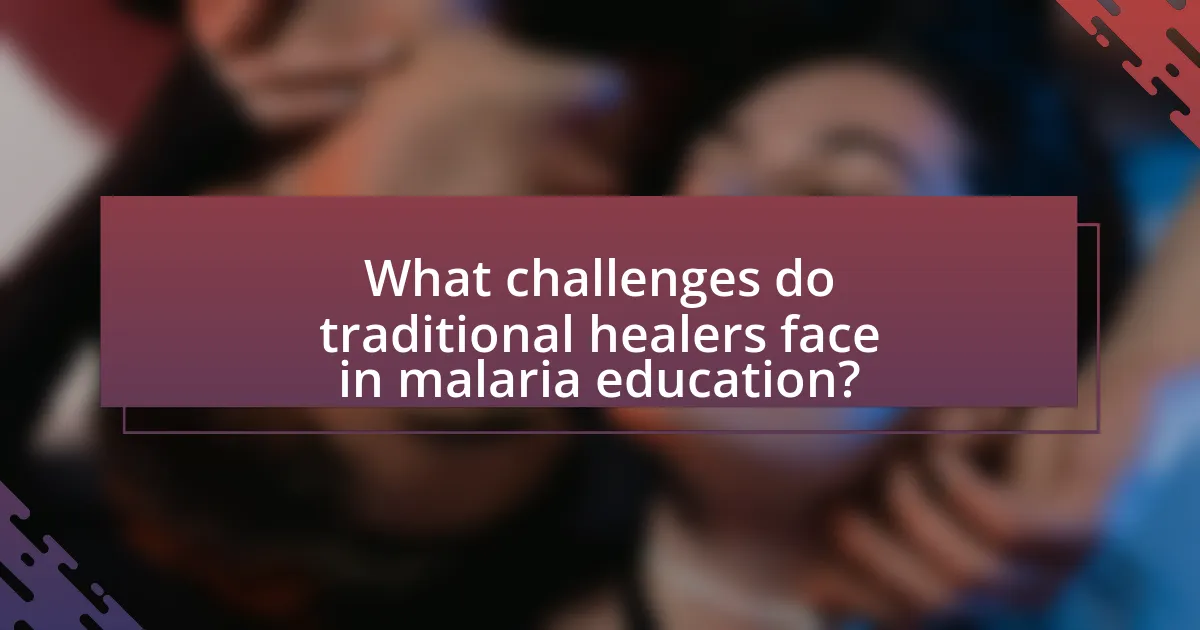
What challenges do traditional healers face in malaria education?
Traditional healers face significant challenges in malaria education, primarily due to a lack of formal training and resources. Many traditional healers operate without access to updated information on malaria prevention and treatment, which limits their ability to educate their communities effectively. Additionally, cultural beliefs and practices may conflict with modern medical advice, creating barriers to the acceptance of scientifically-backed malaria education. Research indicates that traditional healers often lack integration into formal health systems, which further isolates them from essential training and support networks. This disconnection can hinder their role in disseminating accurate malaria information and promoting preventive measures within their communities.
How do misconceptions about malaria affect traditional healing practices?
Misconceptions about malaria significantly hinder the effectiveness of traditional healing practices. Traditional healers may rely on outdated beliefs, such as the idea that malaria is caused by spiritual or supernatural forces, leading them to use ineffective remedies instead of advocating for proven medical treatments. For instance, a study published in the “Malaria Journal” found that traditional healers often misinterpret symptoms, which can delay proper diagnosis and treatment, ultimately worsening patient outcomes. This reliance on misconceptions can perpetuate the cycle of malaria transmission and undermine public health efforts aimed at controlling the disease.
What are the common myths surrounding malaria that traditional healers encounter?
Common myths surrounding malaria that traditional healers encounter include the belief that malaria is caused by bad air or environmental factors rather than by the Anopheles mosquito. Additionally, some individuals think that malaria can be cured solely with herbal remedies without the need for medical treatment. Another prevalent myth is the misconception that only certain populations are at risk, ignoring the fact that malaria can affect anyone in endemic areas. These myths hinder effective malaria prevention and treatment efforts, as evidenced by studies showing that misconceptions about transmission and treatment can lead to increased morbidity and mortality rates in affected communities.
How can traditional healers combat misinformation about malaria?
Traditional healers can combat misinformation about malaria by actively engaging in community education and promoting accurate health information. They can leverage their trusted status within communities to disseminate scientifically accurate details about malaria transmission, prevention, and treatment. For instance, traditional healers can collaborate with health authorities to participate in workshops and training sessions that provide them with up-to-date knowledge on malaria. This collaboration can enhance their credibility and enable them to correct misconceptions directly. Research indicates that community-based interventions, which include the involvement of local healers, significantly improve health literacy and reduce the spread of misinformation (World Health Organization, 2020). By integrating traditional practices with scientifically validated information, healers can effectively address and dispel myths surrounding malaria.
What barriers limit the effectiveness of traditional healers in malaria education?
Barriers that limit the effectiveness of traditional healers in malaria education include a lack of formal training, limited access to updated medical information, and cultural stigma associated with conventional medicine. Traditional healers often lack structured education on malaria prevention and treatment, which hinders their ability to provide accurate information. Additionally, many traditional healers do not have access to the latest research or guidelines on malaria, resulting in outdated practices. Cultural perceptions may also lead communities to distrust or undervalue the contributions of traditional healers, further diminishing their role in malaria education.
How does the lack of resources impact traditional healers’ ability to educate?
The lack of resources significantly hinders traditional healers’ ability to educate communities about malaria. Without access to educational materials, training programs, and financial support, traditional healers struggle to disseminate accurate information regarding malaria prevention and treatment. For instance, a study published in the “Journal of Ethnobiology and Ethnomedicine” highlights that inadequate funding limits the capacity of traditional healers to participate in community health initiatives, thereby reducing their effectiveness as educators. This resource scarcity directly impacts their knowledge dissemination, leading to potential misinformation and ineffective health practices within the communities they serve.
What role does government policy play in supporting traditional healers?
Government policy plays a crucial role in supporting traditional healers by providing legal recognition and integrating their practices into the formal healthcare system. This support can enhance the credibility of traditional healers, allowing them to contribute effectively to public health initiatives, such as malaria awareness and education. For instance, in countries like South Africa, government policies have established frameworks that recognize traditional medicine, enabling healers to collaborate with conventional healthcare providers. This integration is vital for addressing health issues like malaria, as traditional healers often serve as the first point of contact for many communities, thereby facilitating early diagnosis and treatment.
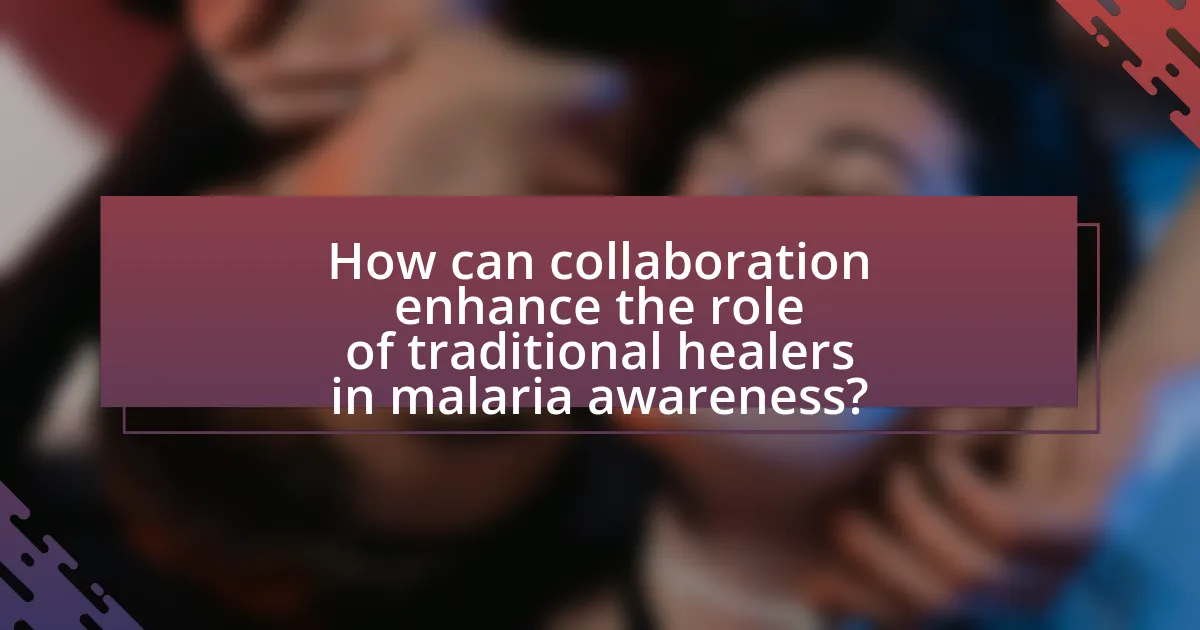
How can collaboration enhance the role of traditional healers in malaria awareness?
Collaboration can enhance the role of traditional healers in malaria awareness by integrating their local knowledge with formal health systems, thereby improving community outreach and education. When traditional healers partner with healthcare professionals, they can share culturally relevant information about malaria prevention and treatment, which increases community trust and acceptance of health messages. For instance, a study published in the “Journal of Ethnobiology and Ethnomedicine” found that communities with collaborative programs between traditional healers and health authorities reported higher awareness levels of malaria prevention methods. This synergy not only empowers traditional healers but also ensures that malaria awareness campaigns are more effective and resonate with local populations.
What partnerships can be formed between traditional healers and health organizations?
Partnerships between traditional healers and health organizations can include collaborative training programs, referral systems, and community health initiatives. Collaborative training programs enable traditional healers to gain knowledge about modern medical practices, enhancing their ability to provide comprehensive care. Referral systems allow traditional healers to direct patients to health organizations for conditions beyond their expertise, ensuring better health outcomes. Community health initiatives can leverage the trust traditional healers have within their communities to promote malaria awareness and education, thereby increasing prevention and treatment efforts. These partnerships can be supported by evidence from studies showing that integrating traditional and modern health practices improves healthcare access and effectiveness in rural areas.
How can training programs improve the knowledge of traditional healers regarding malaria?
Training programs can improve the knowledge of traditional healers regarding malaria by providing them with evidence-based information about the disease, its transmission, prevention, and treatment options. These programs can enhance their understanding of malaria’s clinical manifestations and the importance of timely diagnosis and referral to healthcare facilities. For instance, studies have shown that training initiatives, such as those implemented by the World Health Organization, have successfully increased the awareness and skills of traditional healers, enabling them to better educate their communities about malaria prevention methods, such as the use of insecticide-treated nets and the importance of seeking medical care. This improved knowledge ultimately contributes to better health outcomes in communities where traditional healers play a significant role in healthcare delivery.
What benefits arise from integrating traditional healing practices with modern medicine?
Integrating traditional healing practices with modern medicine enhances patient care by combining holistic approaches with scientific advancements. This integration allows for a more comprehensive understanding of health, as traditional practices often emphasize prevention and community involvement, which can improve patient adherence to treatment plans. For instance, studies have shown that in regions where traditional healers collaborate with healthcare systems, there is a notable increase in malaria awareness and treatment uptake, leading to better health outcomes. This collaborative approach not only respects cultural beliefs but also leverages the strengths of both systems, ultimately resulting in improved healthcare access and effectiveness.
What strategies can traditional healers adopt to improve malaria education?
Traditional healers can adopt community engagement and collaboration with health authorities as key strategies to improve malaria education. By actively participating in community health workshops and training sessions, traditional healers can disseminate accurate information about malaria prevention and treatment. Research indicates that integrating traditional healers into formal health systems enhances health education outreach, as they are trusted figures within their communities. For instance, a study published in the “Journal of Ethnobiology and Ethnomedicine” highlights that traditional healers who collaborate with local health departments can effectively communicate the importance of using insecticide-treated nets and seeking prompt medical care for malaria symptoms. This partnership not only elevates the credibility of malaria education but also fosters a holistic approach to health that respects cultural practices while promoting evidence-based interventions.
How can traditional healers utilize community events for malaria awareness campaigns?
Traditional healers can utilize community events for malaria awareness campaigns by organizing educational workshops and health fairs that focus on malaria prevention and treatment. These events allow traditional healers to share their knowledge of local medicinal plants and practices that can complement conventional malaria treatments. For instance, studies have shown that integrating traditional medicine with modern healthcare can enhance community trust and participation in health initiatives, leading to improved health outcomes. By actively engaging in community gatherings, traditional healers can also dispel myths about malaria, promote the use of insecticide-treated nets, and encourage timely medical consultations, thereby increasing overall awareness and reducing malaria incidence in their communities.
What role does storytelling play in educating communities about malaria?
Storytelling plays a crucial role in educating communities about malaria by effectively conveying important health information in a relatable and memorable manner. Through narratives, traditional healers can share personal experiences and cultural beliefs that resonate with community members, making the information more accessible and engaging. For instance, storytelling can illustrate the symptoms of malaria, prevention methods, and the importance of seeking treatment, thereby enhancing understanding and retention of knowledge. Research indicates that culturally relevant stories can significantly improve health literacy and influence behavior change, as evidenced by a study published in the Journal of Health Communication, which found that storytelling increased awareness and understanding of malaria in rural populations.
What practical tips can traditional healers implement for effective malaria education?
Traditional healers can implement community workshops to educate individuals about malaria prevention and treatment. These workshops can include demonstrations of mosquito net usage, the importance of environmental sanitation, and the identification of malaria symptoms. Evidence shows that community-based education significantly increases awareness and reduces malaria incidence; for instance, a study published in the American Journal of Tropical Medicine and Hygiene found that community engagement led to a 30% reduction in malaria cases in targeted areas. Additionally, traditional healers can collaborate with local health authorities to distribute educational materials that emphasize the importance of seeking medical treatment alongside traditional remedies, ensuring a comprehensive approach to malaria education.
